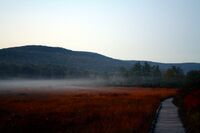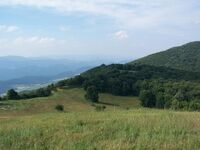Biology:Appalachian bogs
Appalachian bogs are boreal or hemiboreal ecosystems, which occur in many places in the Appalachian Mountains, particularly the Allegheny and Blue Ridge subranges.[1][2] Though popularly called bogs, many of them are technically fens.[3]
Natural history
After the Pleistocene ice ages, species and ecosystems that had shifted southward often survived in local refugia. As a result, cold-adapted ecosystems, such as bogs, remain as far south as East Tennessee and Western North Carolina.[4] Development of land has greatly reduced both the number and acreage of the bogs in North Carolina.[5] Bog ecosystems evolved in humid cold temperate regions and are generally ombrotrophic which means the system is dependent on precipitation for moisture and nutrient inputs.[6]
Shady Valley bogs
Situated between Holston Mountain and the Iron Mountains, the community of Shady Valley, Tennessee, once contained an estimated 10,000 acres (40 km²) of cranberry bogs.[7] In recent years, The Nature Conservancy has initiated a bog restoration program in Shady Valley.[8] The Conservancy also sponsors the town's annual Cranberry Festival, which is held the second weekend in October.[9][10]
Notable bog preserves
- Cranberry Glades, in Pocahontas County, West Virginia
- Cranesville Swamp Preserve, in Preston County, West Virginia and Garrett County, Maryland
- Mountain Bogs National Wildlife Refuge in Ashe County, North Carolina.
- Tamarack Swamp, in Pennsylvania's West Branch Susquehanna Valley
- Tannersville Cranberry Bog, in Northeastern Pennsylvania
Cataract bogs
A cataract bog is a rare ecological community, formed where a permanent stream flows over a granite outcropping. The sheeting of water keeps the edges of the rock wet without eroding the soil, but in this precarious location no tree or large shrub can maintain a roothold. The result is a narrow, permanently wet, sunny habitat.
While a cataract bog is host to plants typical of a bog, it is technically a fen, not a bog. Bogs get water from the atmosphere, while fens get their water from groundwater seepage.[11]
Cataract bogs inhabit a narrow, linear zone next to the stream, and are partly shaded by trees and shrubs in the adjacent plant communities.[12]
Cataract bogs are found only in the Southern Appalachian Mountains of the United States , at elevations of between 1,200 and 2,400 feet (370 and 730 m). They are restricted to the Blue Ridge Escarpment region of South Carolina and a small area of North Carolina, a region with exceptionally high rainfall.[11]
Sods
Sods is a term used in the Allegheny Mountains of eastern West Virginia for a mountaintop meadow or bog, in an area that is otherwise generally forested. The term is similar (perhaps identical) to that of a "grass bald", a more widespread designation applied throughout the central and southern Appalachian region.
The best known example of a sods is Dolly Sods, a federally designated wilderness area in Tucker County, West Virginia and popular destination for recreationalists. Other examples include Nelson Sods (Pendleton County) and Baker Sods (Randolph County).
See also
- Appalachian balds
- Appalachian temperate rainforest
- Cove (Appalachian Mountains)
- Southern Appalachian spruce–fir forest
- Fen
References
- ↑ Mountain Bogsfws.gov
- ↑ "Mountain Bogs National Wildlife Refuge | U.S. Fish & Wildlife Service". https://www.fws.gov/refuge/mountain_bogs/.
- ↑ Archived at Ghostarchive and the Wayback Machine: Southern Appalachian Cranberry Bog. YouTube.
- ↑ "Appalachian-Blue Ridge forests". Terrestrial Ecoregions. World Wildlife Fund. http://worldwildlife.org/ecoregions/na0403.
- ↑ Archived at Ghostarchive and the Wayback Machine: Southern Appalachian Cranberry Bog. YouTube.
- ↑ Access Suspended. doi:10.3375/043.030.0407. https://bioone.org/access-suspended. Retrieved 2022-03-02.
- ↑ Davis, Donald Edward. Where There Are Mountains: An Environmental History of the Southern Appalachians. University of Georgia Press, 2002, p. 13.
- ↑ Wild SideTV-Shady Valley Bog Restoration.mpg. YouTube. Archived from the original on 2021-12-09.
- ↑ "Shady Valley Cranberry Festival | the Nature Conservancy". http://www.nature.org/ourinitiatives/regions/northamerica/unitedstates/tennessee/explore/shady-valley-cranberry-festival.xml.
- ↑ "Shady Valley Cranberry Festival - Johnson County Chamber". http://johnsoncountytnchamber.org/event/shady-valley-cranberry-festival-4/.
- ↑ 11.0 11.1 McMillan, Patrick. "Mountain Bogs on the Verge of Vanishing". Expeditions with Patrick McMillan. Archived from the original on 29 July 2011. https://web.archive.org/web/20110729051109/http://www.myoutdoortv.com/wildlife/expeditions-with-patrick-mcmillan. Retrieved 18 September 2016.
- ↑ Porcher, Richard Dwight (2001). A Guide to the Wildflowers of South Carolina. Columbia, South Carolina: University of South Carolina Press. p. 71. ISBN 1-57003-438-9.
 |




